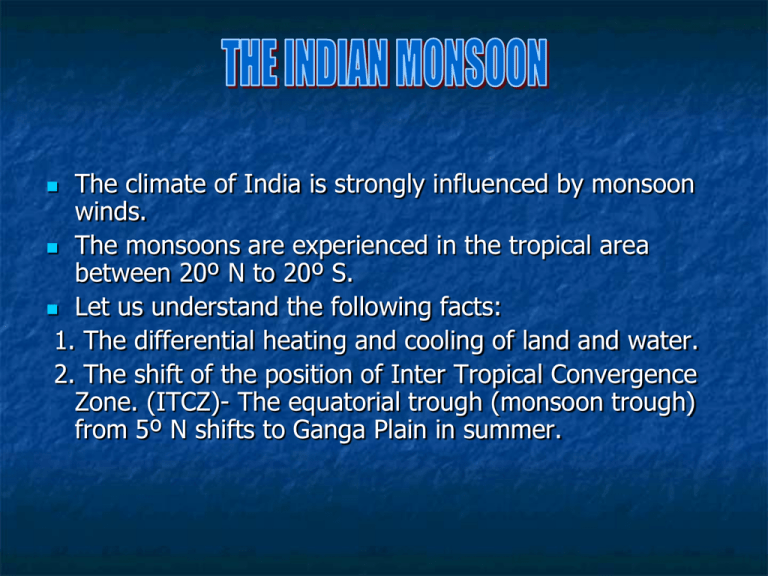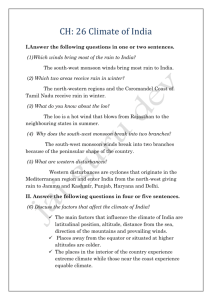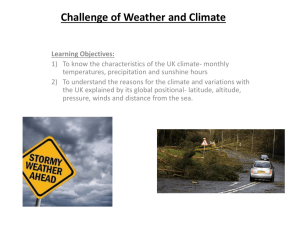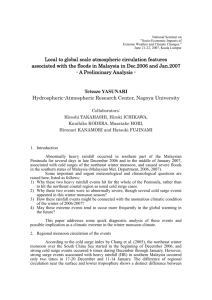Climatic - WordPress.com
advertisement

The climate of India is strongly influenced by monsoon winds. The monsoons are experienced in the tropical area between 20º N to 20º S. Let us understand the following facts: 1. The differential heating and cooling of land and water. 2. The shift of the position of Inter Tropical Convergence Zone. (ITCZ)- The equatorial trough (monsoon trough) from 5º N shifts to Ganga Plain in summer. 3. The presence of the high pressure area, east of Madagascar. (approx. at 20º over the Indian ocean.) The intensity and position of the this high pressure effects the IM 4.The Tibetan plateau gets intensely heated during summer and which results in strong vertical air currents and low pressure at 8 km above the sea level. 5. The movement of westerly jet stream to the north of Himalayas and the presence of tropical easterly jet stream over the Indian Peninsula. Deserts & winds 1) Deserts: where & why Middle-latitude deserts u exist in rain shadows. Deserts & winds 1) Deserts: where & why SOUTHERN OSCILLATION Changes in the pressure conditions over the southern ocean also affect the monsoon. Normal condition- The tropical eastern south Pacific ocean experiences high pressure and the tropical eastern Indian ocean experience low pressure. But in certain years there is a reversal in the above condition. This periodic change is known as SO. EL NINO EL NINO EVENT connected to SO- During which a warm ocean current that flows past the Peruvian Coast, in place of the cold Peruvian current, every 2 to 5 years. The changes in pressure conditions are connected to the El Nino. HOW TO PREDICT THE INTENSITY OF MONSOON The difference in pressure over Tahiti and Darwin in north Australia (Pacific ocean, 18º S/149º W and Indian Ocean 12º30’S/131ºE) is computed. If the pressure difference were negative, it would mean below average and late monsoon. The onset of monsoon Monsoon winds are affected by different atmospheric conditions. In May- summer month, the temperature riseslow pressure trough is developed. In June this trough attracts south-east trade winds from the south of equator. These moisture carrying winds deflect right in lands and known as southwesterly winds. These strong winds overrun the whole country in a months time. DIVISION OF MONSOON WINDS BY PENINSULA THE ARABIAN SEA BRANCH It enters Kerela till 1st June. It reaches Mumbai till 10th June. It arrives over Saurashtra-Kuchchh and central India till Mid June THE BAY OF BENGAL BRACH It advances rapidly and reaches in Assam in the 1st week of June. It turns to Ganga Plain because of Mountain range It causes rain in Delhi till 29th June and in Punjab till 5th July. Merging of branches Both the branches merge over northwestern part of Ganga Plain. In the western Himalayas ( Himachal Pradesh) They cause heavy rainfall. The islands receive the very first monsoon from south to north from the 1st week of April to 1st week of May. WITHDRAWAL OF MONSOON It begins in north-western states by early sep. It withdraws completely from the northern half of peninsula till mid oct. in slow pace. It withdraws from southern part rapidly. By early Dec. Withdrawal is completed. From the islands withdrawal takes place from 1st week of Dec. to 1st week of Jan from north to south direction. THE SEASONS THE COLD WINTER SEASON Northern India ( Mid Nov. to Feb.) Dec. and Jan. coldest months Normal tem. 10º to 15ºC Days are warmer than nights Frost in common in north and snowfall in Himalayas The northern trade winds prevail over country. They do not cause rain in north india.(Land to sea) NORTHERN INDIA In northern india high pressure regions develops and with light winds moving outwards from this area. Because of relief these winds blow through Ganga valley from west to the northwest. Clear sky, low temp., and variable winds. Rain fall- The two parts of india get rainfall. 1. North-west part of india- from the Mediterranean cyclones. 2.Tamil Nadu- north-east winds which blow over the Bay of Begal. SOUTHERN INDIA Average Tem- 24º-25 Temperature decrease from south to north. The peninsula region does not have well defined cold season due to moderating influence of the sea. THE HOT WEATHER SEASON march to may Heat belt shifts from south to north- due to the apparent movement of sun. In March, April and May the highest temp. occur in The Deccan (38ºC), Gujarat (42ºC) and North-west of India(45ºC). In may rising temp. leads to a low pressure in a wider area from Thar Desert to Chhota Nagpur. Due to low pressure, the moisture-laden winds from the Arabian Sea are attracted towards this area. Consequently there is (about 158cm) rainfall in the Raj Mahal and Chhota Nagpur hills lying between the Satpuras and the Vindhyas. Kerala and Karnataka also experience the premonsoon showers. They help in early ripening of mangoes- so also known as Mango showers In Peninsula temp. remains lower due to the moderating influence of oceans. Other Climatic Features 1. Loo- Strong, gusty, hot and dry winds blowing over north and north-west during the day (Sometimes until late in the evening). 2. Dust storms-In may in north. They bring temporary relief rain and cool breeze. Thunderstorms-with violent winds, torrential downpour with hails.-In west Bengal these are known as Kaal Baisakhi. ADVANCING MONSOON RAINY SEASON In June the low pressure in north intensifies. It attracts the south-west trade winds from subtropical areas of southern oceans(Southern hemisphere). They cross the equator and blow in a south-west and enter in Indian Peninsula. They move from sea to land so bring abundant moisture. Speed- 30km/h Break or Burst Early in the season, the windward side of western Ghats receives more than 250cm rainfall but decrease when it goes further. The Deccan Plateau and MP get less rainfall because they are in the rain shadow area. Other branch cause rainfall in north-east (Mawsynram) in Khasi range get heighest rainfall. Rainfall in Ganga valley decreases from east to west. So Gujarat and Rajasthan get scanty rainfall. DRY SPELL OR BREAKS Monsoon has wet and dry spells. Monsoon rains take place only few days at a time. These breaks in monsoon are related to the movement of monsoon trough and its axis keep on moving northward or southward. It determines the spatial distribution of rainfall. DIFFERENTIAL RAINFALL Whenever the axis moves to Himalaya, It gets heavy rainfall and the plains are dry and visa versa. Heavy rainfall brings devastating flood. The frequency and intensity of tropical depressions form at the head of Bay of Bengal and cross over to mainland. The depression follow the axis of the monsoon trough of low pressure. (Effects of rainfall) RETREATING MONSOONS (Transition or Autumn Season) From hot rainy to dry winter During Oct.-Nov. with the apparent movement of the sun towards the south, the low pressure trough become weaker. This is gradually replaced by high pressure. The south-west monsoon winds weaken and start withdrawing gradually. Weather phenomena Clear sky and rise in temp. Days are warm, nights are cool and pleasant. Land is still moist. Oct. heat is present because of rise in temp. and humidity. In northern india temp. starts falling in mid oct. Low pressure over north-west part starts shifting towards Bay of Bengal and create cyclonic disturbances over the Andaman sea. Rain fall These cyclones cross the eastern coast and cause heavy and widespread rainfall. They are often destructive. They struck the deltas of krishna, Godavari and Kaveri. Sometime in Orissa, West Bengal and Bangladesh. The Coromonadel coast is derived from depression and cyclones. DISTRIBUTION OF RAINFALL Regions of heavy rainfall(Over 200 cm rianfall Western slopes of Western Ghats, West Coastal Plain, hills of Meghalaya. Highest rainfall in Mawsynram above 1000cm. Regions of Moderate Rainfall-(100-200cm) Area adjoining to western ghats, Brahmaputra valley, Orissa, Bihar, Jharkhand, Chhatisgarh, MP, some parts of UP, HP, J & K, etc. DISTRIBUTION OF RAINFALL Regions of Low rainfall (50-100cm) Upper ganga valley, parts of Punjab, Haryana, J & K, Andhara Pradesh and Tamil Nadu. Regions of Scanty rainfall (less than 50cm annual rainfall)-Kutch, Leh in Kashmir, Western Rajasthan. Some parts of punjab and Haryana. CAUSES OF UNEVEN DISTRIBUTION 1. Hilly and forest area get heavy rainfall because of high altitude and abundance of trees. 2. The areas without mountains to check rain bearing winds get scanty rainfall. As in Rajasthan, the Aravalli Hills standing parallel to the monsoon. 3. Areas which come in the rain shadow like western side of western ghats or Ladakh. 4. The areas which come first in the way of rain bearing winds get more as compared to areas which come last of all. As Kolkata gets more rain than Delhi.











